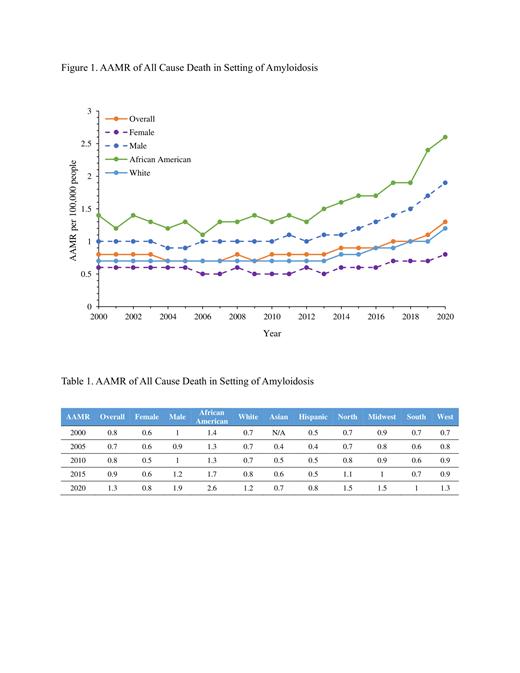Introduction:
Amyloidosis is a collective term for conditions with an abnormal extracellular deposition of amyloid protein. Amyloidosis can be classified based on the location of deposition (localized vs systemic) and by the different subtypes of proteins which are created as a result of a variety of diseases (plasma cell dyscrasias, chronic inflammation, nephrotic syndrome, genetic). Depending on the affected organs, amyloidosis can present with, not limited to, hepatomegaly, renal impairment, nerve conduction impairment, cardiac conduction abnormalities, restrictive cardiomyopathy, and multiorgan failure. In the last century there has been an increase in innovations leading to a better understanding of the pathology, diagnostic tests, staging, and treatment options for amyloidosis. Our study aims to compare all cause mortality trends in adults over 25 years old diagnosed with amyloidosis in the United States.
Methods:
The national mortality trends from 1999 to 2020 for all subtypes of amyloid were analyzed from the CDC WONDER database. The data was extracted using ICD codes E85 (Amyloidosis) with subgroups E85.0 (Non-neuropathic heredofamilial amyloidosis), E85.3 (Secondary systemic amyloidosis), E85.4 (Organ-limited amyloidosis), E85.8 (Other amyloidosis), and E85.9 (Amyloidosis, unspecified. Data was stratified for age groups above 25 years old. Age-adjusted mortality rates (AAMRs) were calculated per 100,000 people and death certificate data was stratified by reported sex, race/ethnicity, and US census region.
Results:
Between 1999 and 2020 there were 40,015 deaths from amyloid. Our analysis revealed that all-cause AAMR per 100,000 people with amyloid showed an increasing trend between 1999 to 2020 (Figure 1). Subgroup analysis on race/ethnicity revealed the AAMR for the Black population has been consistently higher to other groups (Table 1). On average, from 1999 to 2020, the Black population had the highest AAMR (1.52 AAMR) followed by the White population (0.78 AAMR), Hispanic (0.55 AAMR), and Asian (0.5 AAMR). Further subgroup analysis revealed men have a higher AAMR (1.9 AAMR, 2020) compared to women (0.8 AAMR, 2020). Overall there are similar census region trends of all mortality in Amyloid: North (1.5 AAMR, 2020), Midwest (1.5 AAMR, 2020), South (1.0, AAMR, 2020) and West (1.3 AAMR, 2020).
Conclusion:
Due to advancement in technology, amyloid diseases are becoming more widely recognized and increasingly diagnosed. Unfortunately, treatment of amyloidosis remains limited to early diagnosis and treatment of the underlying condition. This includes modalities such as chemotherapy and stem cell transplantation for plasma cell dysplasias and TTR stabilizers for hereditary amyloidosis. These trends in increase in AAMR likely reflect the increased awareness/diagnostics of amyloid disease and complications. The African American population may have higher AAMR due to socioeconomic and environmental factors, health disparities, and research bias. We also suspect men have a higher ATTR than women as it has been reported that ATTR and AL Amyloidosis tends to occur more frequently in men than women and is associated with more severe disease (Kroi et al., 2020, Desport et al., 2012). Further research is necessary to expand on the disparities seen with the ultimate goal of providing targeted therapies to reverse this downward trend.
Disclosures
Koprivnikar:Apellis: Consultancy; Novatis: Consultancy; GSK: Consultancy; Alexion: Consultancy.


This feature is available to Subscribers Only
Sign In or Create an Account Close Modal